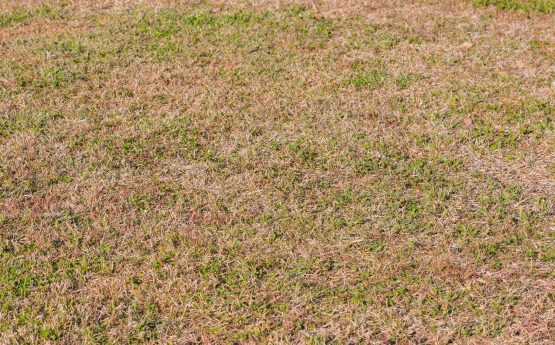Most people might think that brown grass equals dead grass, but this is not always true. The grass might just be dormant and quite the opposite of dead! Dormant grass is grass that is not actively growing. Although it might not be growing, the grass itself is still alive and ready for the next season. It is covered by a layer of dead grass; but underneath, it is actually healthy and full of life.
You can expect to find dormant grasses anywhere from around Thanksgiving (November) to the last frost, which in many cases, occurs in April; but don’t be alarmed by your browning lawn. When temperatures decrease, metabolism in the plant slows down, causing the grass to become dormant. Allen Woerner, owner of Woerner Farms, said “Ultimately what shuts the metabolism down in the plant is when it gets the frost.” This is why it is common to find that your grass turns brown following a winter frost.

Dormant grass is actually super easy to maintain, and much less of a workload. It is not recommended that you water the grass, because when it is dormant it is unable to absorb water and sunlight. Mr. Woerner explained, “I wouldn’t supplement water in the winter. When the plant is truly dormant in the winter it is neither taking on water nor sun, it is just existing.” Watering your dormant grass is not necessary, and neither is fertilizing! He continued, “I would not recommend fertilizing dormant grass in any way.” In fact, nitrogen based fertilizer cannot be used if your grass is not actively growing.
As for spraying for weeds, he added, “You would be making your yard more uniform while spraying for weeds in the winter.” He cautions, though, that you should not continue spraying for weeds when temperatures exceed 85 degrees. When the temperatures get too high, your lawn will experience stress from the heat, and your weeds will become resistant.

temperatures exceed 85 degrees.
As the air begins to warm up, but remains relatively cool, this is the perfect time to install a lawn. As owner of Woerner farms, Mr. Woerner put it, “When you install a lawn in the summer months, it can be a lot more challenging to maintain water in the roots. Right now is an excellent time to be installing a lawn.” New sod can be laid, even if that sod is dormant; and the transition from winter to spring is the best time to lay it. In many cases, it is much less work to lay new sod when it is dormant. And you would not have to mow a dormant lawn like you would during the summer months.
Mr. Woerner concluded that you should “soil test in the winter months so you know what inputs to apply for your growing season.” Dormant grasses will have no effect on your soil test and no negative effect on your lawn. It is perfectly normal and a great opportunity to get a head start at preparing for the summer months.






